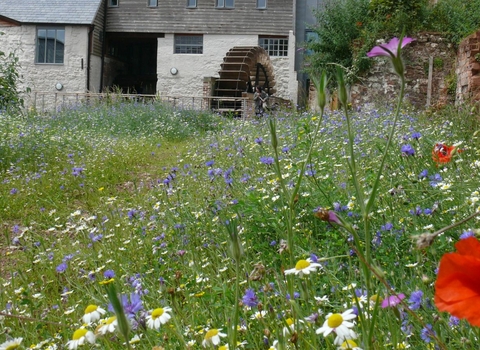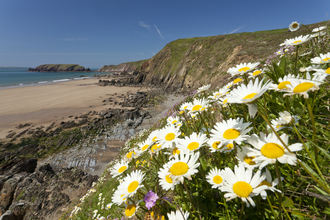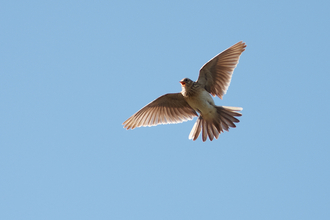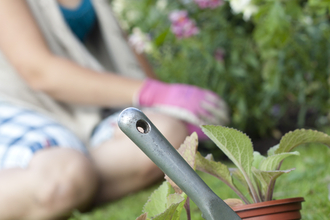Wildlife Gardens
There are a growing number of gardens to visit that have nature at their heart. These haven’t just been abandoned to go wild – they are beautiful, sometimes formal havens, carefully planted and designed with wildlife in mind. From the charming Wind in the Willows garden in Essex, to the fantastically vibrant wildlife garden in the heart of Shrewsbury Abbey’s ruins, there’s a Wildlife Trust reserve to inspire everyone. Look out for insect hotels, hedgehog houses, butterfly plants and pots of honey to buy!
Our gardens are the the perfect places for inspiration on how to bring 'wild' into your life!
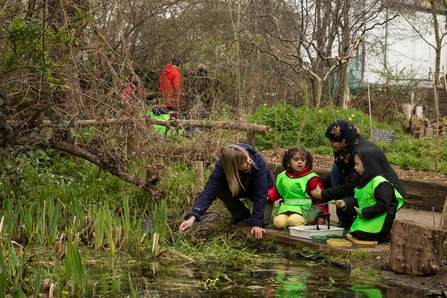
Centre for Wildlife Gardening ©Penny Dixie
Find a wildlife garden
Do a little research in advance and find out some of the best places you can visit to experience a wild garden.
North
Tees Valley Wildlife Trust
Growing Wild Schools Garden - Created to show easy ways to grow fruit and vegetables while attracting a wide range of wildlife, the garden is a previous winner of the Best Community Innovative Garden Award in the Birdwatching Magazine’s wildlife gardening competition. Tees Valley Wildlife Trust have included nectar-rich flowers in the borders to encourage bees and insects to visit our apples and other fruit bushes. The garden is visited by over 1,500 pupils a year, and it is hoped that they will take away ideas to try at home.
There are also two innovative features: a rustic bird cafe designed as a bird table “plus” by Keith Ferry from Woodland Connections, and a habitat wall designed with a multitude of spaces of different sizes for a variety of invertebrates to hide. Species of birds that have visited the bird cafe so far include greater spotted woodpecker, tree sparrow and redpoll. Around the garden are an assortment of bird boxes and insect boxes and a hedgehog box. The rest of the garden includes a variety of plants that can be eaten either by people or birds and includes blackcurrants, alpine strawberries, gooseberries and raspberries.
Yorkshire Wildlife Trust
Wildlife garden in Pearson Park - In the heart of Hull’s busy city centre, is hidden something of a jewel. Small yet perfectly formed, Yorkshire Wildlife Trust’s Pearson Park is an enchanting wildlife garden with ponds, native hedgerows, woodland and a buzzing, beautiful meadow. There’s also a fruit and vegetable patch and a vibrant display garden all of which attracts plenty of wildlife from long-tailed tits to butterflies, shield bugs, ladybirds, solitary bees, and much more.
The stunning mature herb garden was inherited from the previous owners - in spring and summer, the divine scents of rosemary, oregano and sage waft across the whole garden. There are two thriving bee hives on site and last year, the hive produced six litres of simply sublime tasting honey. The wildlife garden is open seven days a week. You’ll find it on the edge of Pearson Park along Princes Avenue in the centre of Hull. Opening hours: 9am-5pm.
East
The Wildlife Trust for Bedfordshire, Cambridgeshire & Northamptonshire
Manor House wildlife garden - The back garden at The Wildlife Trust for Bedfordshire, Cambridgeshire & Northamponshire’s Manor House, Cambourne is small but perfectly formed. It has an attractive flower lined walkway which leads under a now flourishing willow arch (made by a member of staff) with picnic tables beyond. A small pond, fringed by flag irises is home to great crested newts, plentiful water boatmen and other aquatic species as well as white flowering water lilies; dragon and damselflies skim over the surface in summer months.
A few old species of apple tree have been planted (yielding crops of very tasty apples), while various bird feeders full of Vine House Farm seeds keep the resident birds happy and well fed. Open 9-5 Mon-Fri, Manor House, Broad Street, Cambourne CB23 6DH
Essex Wildlife Trust
Warley Place, once a very famous Edwardian garden belonging to Ellen Willmott, is now maintained as a nature reserve by Essex Wildlife Trust. Although the house itself has long since gone, a walk round the paths reveals tantalising glimpses of what the estate once comprised. There are exotic trees, remains of cold frames, greenhouses, reservoirs, a terrace and the conservatory that was part of the original building.
There is no charge for entry, but please remember that even with volunteers giving their time free the maintenance of such a site is still a costly business and your contributions will be welcome and useful. It is a nature reserve not a public garden so some of the facilities you might otherwise expect, such as a gift shop, toilets or tea room, are not available. Dogs, other than guide dogs, are not allowed. Once a month a specialist research group visits the reserve finding, identifying and caring for some of the more unusual species.
‘The Wind in the Willows’ Wildlife Garden - Situated outside the Hanningfield Reservoir Visitor Centre is The Wind in the Willows Wildlife Garden, which opened in 2014. The aim of the project is to give examples of wildlife friendly features that can be copied and adapted in your own garden!
The area is wheelchair accessible with a raised herb bed, wildflower meadow, examples of wildlife friendly planting, hedgehog house, pond, bird feeding area and insect hotel. Look out for signs of our friends from The Wind in the Willows around the reserve too! Opening hours 9am–5pm daily.
Midlands
Shropshire Wildlife Trust
The Cut visitor centre garden, Shropshire Wildlife Trust’s headquarters is an oasis of tranquillity amid the bustle of Shrewsbury town centre. Here you will find herb and flower beds, mini- meadows, unusual fruit trees such as fig and quince, vegetables in season and a solar fountain bursting through an old millstone.
There are always Trust staff around who are happy to answer any questions and you can buy wildlife-friendly plants and bird food here. The garden surrounds the Old Infirmary buildings, once part of Shrewsbury Abbey and which date back to the 13th century. Open to the public free of charge Mon-Sat 10am - 4.30pm.
South
Devon Wildlife Trust
Cricklepit Mill - For an urban site, Devon Wildlife Trust’s Mill has an extraordinary wealth of wildlife. Over 200 species of plants flourish in the wildlife garden, which is managed by volunteers for the benefit of local wildlife. Having flowing water passing through means that fish and waterfowl are regularly seen, a moorhen pair live on part of the site and successfully breed each year. Small fish frequently attract kingfishers and little egrets, while other regular visitors include grey wagtails and dippers.
Over 50 species of insects have been recorded in the garden and in the summer several species of bee can be seen buzzing around nectar-rich plants, including nesting mason and leafcutter bees that make use of the bug hotel to lay eggs and six spot burnet moths can be found hatching in the grass meadow. The garden is a green oasis in an otherwise urban surrounding, and is free to visit (donations always welcome). Open Monday to Friday, 9am-5pm.
Herefordshire Wildlife Trust
Lower House Farm’s wildlife garden - The design of the garden was led by Dr Anthea Turner and Chris Evans following Hereford Wildlife Trust’s purchasing of the farmhouse in 1995. An informal cottage garden design, the plants along the main border are mainly old-fashioned garden varieties of native wildflowers and a pond and seating areas are dotted amongst the planting.
The lawn has been allowed to grow as a wildflower meadow with mown paths through the sward, a venerable pollarded weeping willow shading its centre. A laid hedge of elm and hawthorn boundaries the lane while to the rear of the farmhouse is the orchard which leads onto Lugg Meadow – an historic Lammas meadow. The garden is managed with wildlife in mind not only through the planting but with log piles, a large compost heap, bee houses and the sensitive hands of the wonderful volunteer gardeners.
London Wildlife Trust
Centre for Wildlife Gardening - This much-loved London Wildlife Trust community garden has been delighting local residents for over 25 years now. Located behind a quiet residential street, it’s the perfect place to enjoy inner city nature, to learn and to relax. The centre runs regular, free family-friendly events and works closely with the local community.
Footpaths around the reserve are accessible for wheelchairs and pushchairs and toilet facilities are available. The Centre for Wildlife Gardening is located at 28 Marsden Road, Peckham, London, SE15 4EE and is a seven minute walk from East Dulwich station. On street parking is available. Telephone 020 7252 9186. Open on Tuesdays, Wednesdays, Thursdays and Sundays from 10:30am-4:30pm.
Scotland
Scottish Wildlife Trust
Johnson's Terrace Garden - The Scottish Wildlife Trust’s smallest reserve is located in the heart of Edinburgh’s Old Town, near to Edinburgh Castle. It demonstrates how a small, neglected urban area can be converted into an invaluable wildlife refuge. Hopefully, visitors will find inspiration to improve their own gardens for wildlife. Note that access is through a locked gate - you must arrange a visit by contacting the Trust’s head office.
Jupiter Urban Wildlife Garden is one of Scotland's finest examples of the reclamation of disused industrial land for wildlife and people. This urban nature oasis is right in the middle of industrial Grangemouth and is a haven for birds, butterflies and wildflowers. The Centre offers a fantastic place to explore and relax – with the opportunity to walk, picnic or even use of the BBQ.
There are a number of self-led activities to try including pond dipping, mini beast safaris and tree orienteering. Look out for the wildlife gardens showing how you can attract more wildlife at home and regular events, such as guided walks, children's activities and much more. Wildflowers are also available to buy from partners, TCV Scotland's Jupiter Wildflower Nursery.
If you can't get to these places
Can’t see a reserve close to you? Find a Wildlife Trust here to contact for advice on a suitable and beautiful place to visit. Don’t forget to check out our advice on gardening for wildlife, and look out for events run by The Wildlife Trusts.
More wildlife experiences
From seeing colourful wildflowers to spotting magnificent birds of prey, we can help you get closer to wildlife across the UK.

